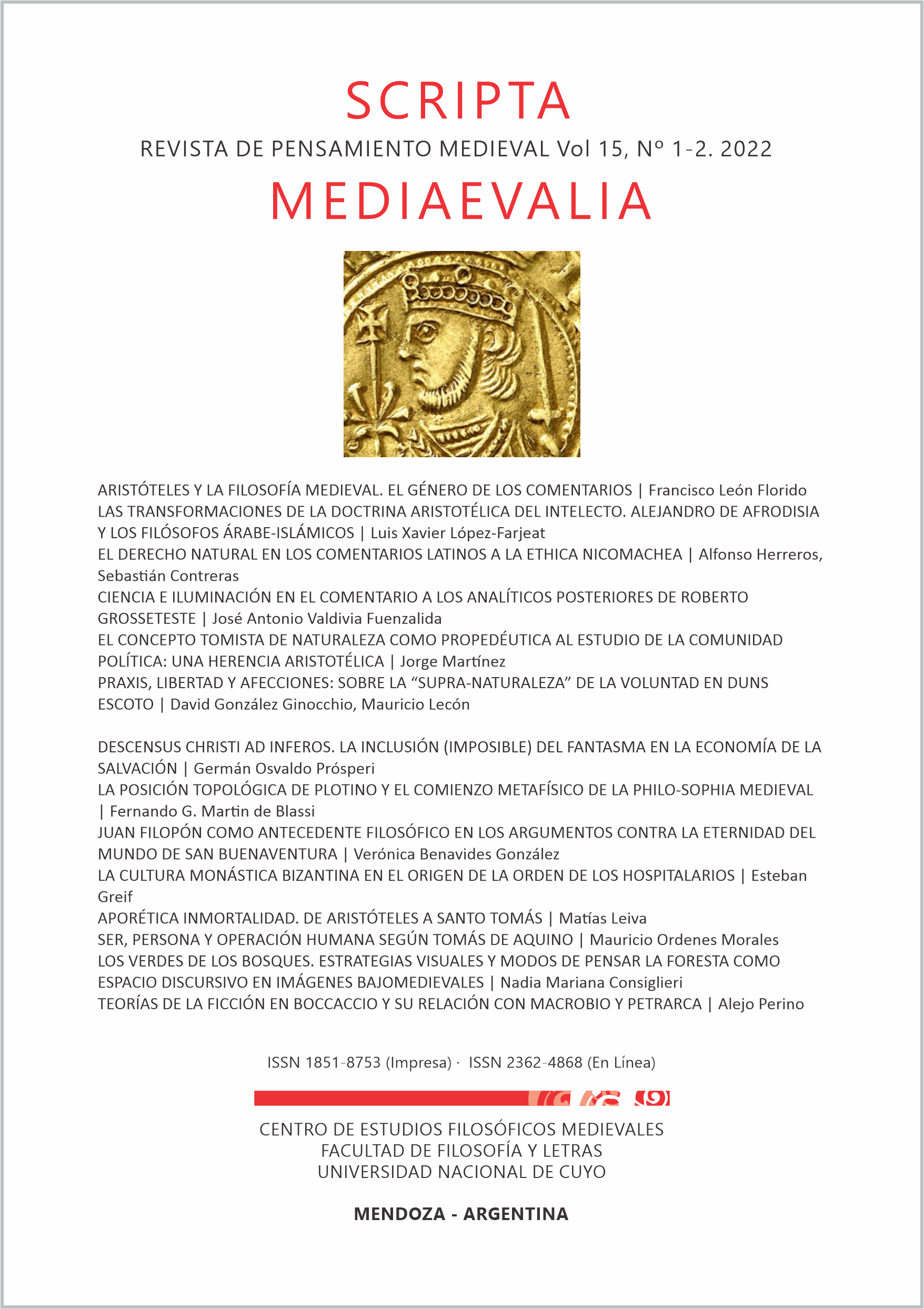Descensus Christi ad inferos. The (impossible) inclusion of the phantom in the economy of salvation
DOI:
https://doi.org/10.48162/rev.35.015Keywords:
Underworld, Sheol, Hades, Phantom, ChristAbstract
This article aims at demonstrating that ancient Hebrews and Greeks considered that the world of the dead —in its neutral sense (non-moral), i.e., as sheol or hadēs— represents a dimension beyond the divine or the human, a dimension the dogmatic Christology cannot possibly embrace. We will argue that descensus Christi ad inferos, from this perspective, constitutes the device the (proto)orthodox theology has construed, since the early days, to conjure up the imaginal and phantasmatic realm of the dead.
References
Alexandre, J. Une chair pour la gloire: L’Anthropologie réaliste et mystique de Tertullien. Paris: Beauchesne Éditeur. 2001.
Bagchi, D. “Christ’s Descent into Hell in Reformation Controversy”. Studies in Church History, v. 45, (2009): 228-247.
Balthasar, H. U. Explorations in Theology, Vol. IV: Spirit and Institution. San Francisco: Ignatius Press, 1995.
Barr, J. The Garden of Eden and the Hope of Immortality. The Read-Tuckwell Lectures for 1990. London: SCM Press Ltd, 1992.
Bernstein, A. E. The Formation of Hell. Death and Retribution in the Ancient and Early Christian Worlds. London: UCL Press, 2003.
Blanchot, M. L’entretien infini. Paris: Gallimard, 1969.
Block, B. “Beyond the Grave: Ezekiel's Vision of Death and Afterlife”. Bulletin for Biblical Research, v. 2, (1992): 113-141.
Bremmer, J. The Early Greek Concept of the Soul. New Jersey: Princeton University Press, 1983.
Campbell, J. J. “To Hell and Back: Latin Tradition and Literary Use of the Descensus ad inferos”. Viator 13 (1982): 107-158.
Cantalamessa, R. La cristologia di Tertulliano. Friburgo: Edizioni Universitarie Friburgo Svizzera, 1962.
Claus, D. B. Toward the Soul. An Inquiry into the Meaning of Psyche before Plato. London: Yale University Press - New Haven, 1981.
Connell, M. F. “Descensus Christi ad Inferos: Christ’s Descent to the Dead”. Theological Studies, v. 62, (2001): 262-282.
D’Costa, G. “The Descent into Hell as a Solution for the Problem of the Fate of the Unevangelized Non-Christians: Balthasar’s Hell, the Limbo of the Fathers and Purgatory”. International Journal of Systematic Theology, v. 11, (2009): 146-171.
Daniélou, J. From Shadow to Reality. Studies in The Biblical Typology of The Fathers. London: Burns & Oates, 1960.
De Amenábar, M. C. Muerte. Transfiguración de la vida. Santiago de Chile: Ediciones Universidad Católica de Chile, 1998.
Debray, R. Vie et mort de l’image. Une histoire du regard en Occident. Paris: Gallimard, 1992.
Deleuze, G. Logique du sens. Paris: Minuit, 1969.
Finney, M. T. Resurrection, Hell and the Afterlife. Body and Soul in Antiquity, Judaism and Early Christianity. New York, London: Routledge, 2016.
Galot, J. “La descente du Christ aux enfers”. Nouvelle Revue Théologique, v. 83, (1961): 471-491.
Johnston, P. Shades of Sheol: Death and Afterlife in the Old Testament. Illinois: InterVarsity Press, 2002.
Lawrence, L. “The Harrowing of Hell in the Poems of Blathmac and the ‘Gospel of Nicodemus’. Dependence or Convergence?”. Proceedings of the Harvard Celtic Colloquium, v. 15, (1995): 117-128.
Levenson, J. D. Resurrection and the Restoration of Israel. The Ultimate Victory of the God of Life. London: Yale University Press, 2006.
Martin-Achard, M. La mort en face selon la Bible hébraïque. Genève: Éditions Labor et Fides, 1988.
Meinong, A. Über die Stellung der Gegenstandstheorie im System der Wissenschaften. Leipzig: R. Voigtländer, 1907.
Oakes E. T. y Moss, D. The Cambridge Companion to Hans Urs von Balthasar. Cambridge: Cambridge University Press, 2004.
Oakes, E. T. “Descensus and Development: A Response to Recent Rejoinders”. International Journal of Systematic Theology, v. 13, n. 1, (2011): 3-24.
Oakes, E. T. “The Internal Logic of Holy Saturday in the Theology of Hans Urs von Balthasar”. International Journal of Systematic Theology, v. 9, (2007): 184–199.
Onians, R. B. The Origins of European Thought: About the Body, the Mind, the Soul, the World, Time and Fate. Cambridge: Cambridge University Press, 1951.
Orbe, A. “El 'Descensus ad inferos' y san Ireneo”. Gregorianum, Vol. 68, No. 3/4 (1987): 499-500.
Otto, W. Theophania: Der Geist der altgriechischen Religion. Hamburg: Rowohlt, 1956.
Pearson, F. “Sheol and Hades in Old and New Testament”. Review & Expositor, v. 35, issue 3, (1938): 304-314.
Pitstick, A. “Development of Doctrine, or Denial? Balthasar’s Holy Saturday and Newman’s Essay”. International Journal of Systematic Theology, v. 11, (2009): 131-145.
Reale, G. Corpo, anima e salute. Il concetto di uomo da Omero a Platone. Milano: Raffaello Cortina Editore, 1999.
Rohde, E. Psyche. Seelencult und Unsterblichkeitsglaube der Griechen, Tübingen - Leipzig: Verlag von J. C. B. Mohr, 1908.
Smith, J. Dust or Dew. Immortality in the Ancient Near East and in Psalm 49. Cambridge: James Clarke and Co., 2012.
Snell, B. Die Entdeckung des Geistes. Studien zur Entstehung des europäischen Denkens bei den Griechen. Göttingen: Vandenhoek & Ruprecht GmbH & Co., 1975.
Suriano, M. A History of Death in the Hebrew Bible. Oxford: Oxford University Press, 2018.
Tertuliano. Adversus Marcionem, Braun, R. (ed.), Contre Marcion. Book 1: Sources Chrétiennes 365 (1990); Book 2: 368 (1991); Book 3: 399 (1994); Book 4: 456 (2001). Paris: Cerf. Dekkers, D. E. (ed.), Corpus Christianorum, vols. I-II. Turnhout: Brepols, 1954. E. Evans (ed.), Against Marcion. Complete edition, text, critical apparatus, notes, translation, latin and english, Oxford, Oxford University Press, 1975.
Trumbower, J. A. Rescue for the Dead: The Posthumous Salvation of Non-Christians in Early Christianity. New York: Oxford University Press, 2001.
Tura, E. Con la bocca e con il cuore. El credo cristiano ieri e oggi. Padova: Edizione Messaggero, 1992.
Turner, R. V. “Descendit Ad Inferos: Medieval Views on Christ’s Descent into Hell and the Salvation of the Ancient Just”. Journal of the History of Ideas, v. 27, n.2 (Apr.-Jun.1966): 173-194.
Van der Toom, K., Becking, B. & Van der Horst, P. W. (eds.). Dictionary of Deities and Demons in the Bible. Leiden - Boston: Brill, 1998.
Zarader, M. L’être et le neutre. À partir de Maurice Blanchot. Paris: Éditions Verdier, 2001.
Downloads
Published
How to Cite
Issue
Section
License

This work is licensed under a Creative Commons Attribution-NonCommercial-ShareAlike 3.0 Unported License.



















